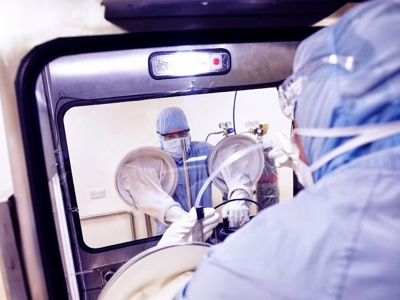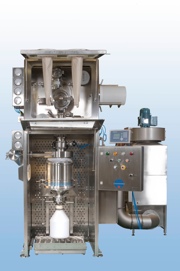The high potency market has seen steady growth in recent times and according to market researcher RNCOS,1 high potency active pharmaceutical ingredients (HAPIs) represent the fastest growing segment in the global API industry. RNCOS estimates this market will reach US$15.3bn by 2017. Such potent active ingredients typically include particular hormones, peptides and cytostatic agents, as well as many new chemical entities (NCEs) that have not yet been completely characterised. Most frequently the compounds are designed for the treatment of cancers, respiratory disorders or hormonal imbalances and the growth has been largely driven by rising demand from the oncology therapeutics market.
Part of this market is being fuelled by the new class of highly potent biopharmaceuticals known as antibody drug conjugates (ADCs), many of which (more than 100, according to market researcher Roots Analysis2) are at the preclinical stage or are just entering clinical trials. It is estimated that by 2023, the market for ADCs could be worth around $9bn (£5.75bn).
High potency handling
The rise in high potency drugs has provided new opportunities for those companies with the capacity and knowhow to handle such specialist materials. Encap’s recent collaboration with Lipocine to manufacture Phase III clinical trial and ICH stability registration batches of Lipocine’s oral testosterone product LPCN 1021 is just one of several recent production deals involving potent materials. Encap Drug Delivery (a division of Capsugel Dosage Form Solutions) has experience in the development, scale-up and commercial manufacturing of this oral dosage form and the product will be manufactured in the company’s high potency suite at the R&D site in Livingston, Scotland.
The past six months have also seen a rapid flurry of investment in new high potency facilities and services. For example, Patheon has expanded its capacity for fully automated and contained manufacture of materials up to Phase IIb. The company says its Milton Park, UK facility will specialise in high-potency and the recent investment means expanded capacity for handling highly potent compounds in the early pharmaceutical development phases, which will feed into later stage and commercialisation capabilities at its site in Bourgoin, France. Marvin Faber, Patheon’s Senior Director, Corporate Environmental Health and Safety, says that Patheon is currently developing more than 400 high-potency projects across the globe.

SCM Pharma has dedicated cleanrooms for the manufacture of potent products.
Picture courtesy of SCM Pharma
Last November, Evonik Industries announced it was broadening its capabilities in finished drug product formulation and clinical supply manufacturing by adding the handling of drug products containing HAPIs in Darmstadt, Germany, and Birmingham, Alabama, US. Dr Thomas Riermeier, Head of the Pharma Polymers & Services, Health Care Business Line, Evonik, said: ‘We are now in a position to offer our customers comprehensive services for the increasingly important class of HAPIs.’ The facilities add to the company’s small and large scale HAPI production capacities in Hanau and Lafayette (Tippecanoe Laboratories).
As a direct result of increasing customer demand, Sigma-Aldrich Corporation’s custom manufacturing services business unit, SAFC, is investing in commercial-scale manufacturing capacity for antibody drug conjugates (ADCs) in St Louis, MO, and is expanding its HAPI manufacturing and storage facilities at the Verona facility near Madison, WI, US.
Carbogen Amcis also completed its capital investment project to upgrade its high potency capabilities last October. The expansions in India and Switzerland include a dedicated chromatography suite for Category 3 and 4 compounds at its niche-scale commercial facility for highly potent APIs in Bubendorf, Switzerland, and a new ISO Class 5 high potency kilo lab with 110m2 of floor space at its large-scale commercial facility for highly potent APIs in Bavla, India.
Equipment trends
In addition to the specialist knowhow needed to handle highly potent materials, the specialised equipment used requires significant investment and running cost. For companies specifying such equipment several trends are in evidence.

Hosakawa Micron offers bespoke design of high potency milling and pack-off equipment with minimal footprints
Energy efficiency: Containment suites require considerable air flow to protect personnel and products, therefore energy performance is an important factor, particularly as energy prices are rising in many regions. Higher performance biosafety cabinets are also being built with more durable parts to ensure that they last longer. Faster cleandown and less downtime for service is also key to equipment design.
More flexibility: As many of the potent materials are new niche drugs or at early stage development, only small batch sizes are required. For contract manufacturers this means providing several products over shorter runs, making production flexibility important. Good cross contamination control is essential and in this respect the use of disposable technologies has increased. Patheon’s Milton Park cites the use of new disposable technology as giving customers greater flexibility in a small footprint.
Ergonomics: Isolator build is often bespoke and, as man hours at the isolator increase, a comfortable and productive work environment is more important. Innovative features such as forearm supports, footrests, slanted viewing sashes and adjustable surface heights are affording operators greater comfort and flexibility. Equipment suppliers are also developing systems that reduce noise and improve access.
As some potent materials require sterile manufacture, demand for such equipment is also growing, with some equipment designers now offering isolators that can be used for both, despite there being different requirements in terms of air flow and sterilisation. Once a product has reached the commercial stage, the protective systems have to cover all production stages – from milling and blending through to tableting or filling and packing. The main principle is to separate the operator from the production process, and new equipment designs keep manual intervention to a minimum.
Characterising materials
Because the toxicity of new chemical entities is a relative unknown, before any of the production processes can begin, manufacturers must characterise and understand the materials they are handling. This enables the required level of safe handling to be determined. As a result, toxicity modelling services (based on similar chemicals) as well as consultancy services in setting occupational exposure levels are other growing areas being contracted out to specialists.
References
1. Global API Market Forecast to 2017 - www.rncos.com
2. www.rootsanalysis.com




